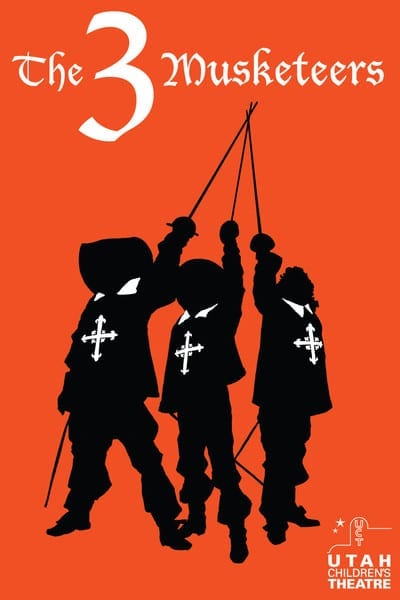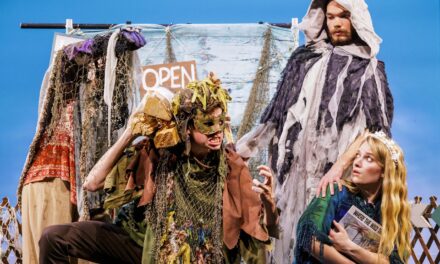SOUTH SALT LAKE — The Three Musketeers at the Utah Children’s Theatre is a rollicking good time for the family. Pared down to a very manageable (i.e., less than two hour) time frame, even the youngest members of your family can enjoy the classic adventure tale with a touch of romance, and learn anew the meaning of “all for one, and one for all!” The Utah Children’s Theatre specializes in bringing favorite stories to the stage, from classics such as The Three Musketeers, to recent additions to the children’s theatre canon such as Lily’s Purple Plastic Purse. This script, adapted and directed by Joanne M. Parker, engages the audience members and provides lots of fun while retelling Alexander Dumas‘s famous story.
The storyline is pared down to the bare minimum needed to retell the plot, with a heavy focus on sword-fighting, duels, intrigues and a tiniest hint of romance. At the heart of the story is the brash and fiery D’Artagnan, played by Spencer Hohl, a handsome young man who has some skill with a fencing blade and a dream to follow in his father’s footsteps to become a Musketeer, a member of the elite guard who protect the French King Louis XIV. On his way to Paris D’Artagnan causes young ladies to swoon and rivals to seethe, and he makes friends and enemies with equal ease.
D’Artagnan meets the lovely Constance (Jasmine Jones), a lady-in-waiting to the young Queen Anne (Sofia Rahaniotis) newly wed to the teenaged King Louis (Cameron Ballard). Because of their youth, the King and Queen are vulnerable to the wily machinations of the evil Cardinal Richelieu (Steve Harmon) who wishes to seize the throne of France for himself. Cardinal Richelieu, with the aid of his scowling henchman, the one-eyed Rochefort (Landon Kraczek), schemes to disband the Musketeers, and force them all the turn in their uniforms and weapons, leaving the King unprotected and alone. However, three members of the King’s guard, Athos (Adam Argyle), Aramis (Zackery Western) and the portly Porthos (Oran de Baritault) are suspicious of Richelieu’s motives and resist, instead choosing to go into hiding and staying committed to the King. When D’Artagnan arrives in Paris and discovers there are no more Musketeers, he is understandably very disappointed. But of course, he doesn’t give up on his lifelong dream, and along the way he is thrust headlong into the political intrigue unfolding in Paris.
Despite my lengthy synopsis, Parker’s script is fairly straight-forward and easy to follow. My theatre companion (my 10-year-old daughter) only needed a little bit of clarification at intermission to be able to follow the storyline and stay involved in the play. The many sword fighting sequences choreographed by Caroline Haydon were humorous and well-rehearsed. The fights ran the gamut from duels between two men to full out brawls in taverns and along the streets of Paris. They were fun to watch and helped move the story along briskly. Our favorite scene in the play, though, took place in a tavern, where Porthos and Athos try to teach D’Artagnan “how to woo a woman,” using various methods of flattery and adulation. It was a funny and entertaining scene that my daughter loved and which typified the fun character of the script.
Parker directs the actors in this production with broad strokes. The Musketeers are brave and heroic, and run around and yell a lot: at D’Artagnan, at the Cardinal, at each other, but the actors are fully committed to their characters and the action. The Cardinal and Rochefort plot and scheme like villains in a melodrama, complete with an eye patch and a mustache—a nice touch for a play for young audiences.. Spencer Hohl as D’Artagnan is so adorable to look at that I forget that his character is kind of a cad, and my daughter and I cheered when he wins his lady fair at the end of the day. The weakest link in the performance might have been the young royals, King Louis and Queen Anne, although their stiffness and stilted words could possibly be explained away by the very grown-up responsibilities these young characters were required to undertake, and their inexperience both as rulers and as marriage partners. In one moment of seriousness, a perceived betrayal is revealed as rather a twist of fate, and a long held grudge is forgiven between Athos and his erstwhile wife, which is both heartfelt and tidily resolved so that our stalwart swashbuckler can get back to the real business at hand, i.e. more sword fighting.
The costume design by Cathy Maurer and Christina Wilson helped immensely in keeping characters divided into the good guys (Musketeers, in blue tunics) and the bad guys (Richelieu’s men, in red tunics). The production design by James Parker made use of levels and nooks and crannies to keep the stage pictures interesting. The lighting and sound design (also by James Parker) used classical music to underscore the action to great effect, and made clever use of lighting techniques to simulate explosions.
Overall, it was a tight, well-rehearsed production. The Three Musketeers is solid entertainment for the family that may even foster an interesting discussion about history with young audience members. The staging is effective and entertaining, the characters are well-drawn and easily identifiable, and the storyline, of course, is a classic. Take the family, cheer on the good guys, sneer at the bad guys, and your little ones might go to sleep tonight dreaming of swash-buckling and rescuing damsels in distress, all while proving their friendship by yelling, “All for one, and one for all!”





